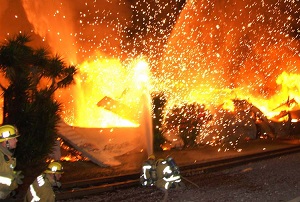|
Titanium melting point – primary data and some other interesting aspects
However, this is still a high value, especially for a metal that has overcome the “rare metal” status and it is now looked upon as a standard structural engineering material. Some other metals that have melting points higher than titanium melting point are rhodium, tantalum, iridium, thorium, and vanadium – all which are very rare and difficult to process in large quantities. That’s why titanium is still sought for applications which require heat resistant properties. It is also worth nothing that the titanium melting point presented above is specific to pure titanium metal. Just by altering the diffusion mobility of titanium atoms the melting point can be increased by 450 to 500 °C for pure titanium. Titanium based alloys, especially those that emphasize dispersion strengthening, can be manufactured to achieve much higher melting points. One of the most popular titanium applications, which accounts for a large percentage of titanium tubing consumption, is in industrial heat exchangers. You may think that titanium popularity for these particular applications is depending on titanium heat resistance. In fact, titanium is used in heat exchangers for the same reasons that it is used in other process equipment for handling of corrosive fluids effectively with minimal equipment degradation. Titanium shell and tube heat exchangers are frequently required for high pressure, highly corrosive processes. These titanium tube exchangers typically require a combination of solid titanium and titanium-steel clad components, including tube sheets, shells, and bonnets. The titanium heat resistance really shines in those applications that also require high strength and corrosion resistance at the same time. The most obvious choice is in gas turbine engines – these are your typical jet engines that you can be seen under the wings of jet aircraft. Most specifically in compressor parts. In there the environmental conditions are extremely severe, especially with the increasing of temperature and pressure. The corresponding increase in the incidence of rapid oxidation resulting in extensive damage and corrosion rates of as much as 7.6 cm/sec.
Most titanium alloys are pretty fire resistant… you can weld them, grind them (producing a shower of white – not yellow – sparks), zap them with laser welding equipment, and the most they’ll do is melt. But pure titanium is reasonably bad news and pretty much any titanium alloy will combust if you get it hot enough, and then supply enough oxidizer. Spontaneous ignition of massive shapes of titanium can occur at room temperature when a fresh, oxide-free metal surface is exposed to oxygen under pressure. Such a surface can be produced by the rupture of a titanium specimen under tension. If these surfaces are exposed to oxygen pressure in excess of 350 p.s.i. spontaneous ignition of the sample occurs. Spontaneous ignition at various concentrations of oxygen was investigated and the effect of temperature on ignition limits was also determined. The preliminary results suggest that ignition will occur only if the initial reaction is vigorous enough to raise the surface temperature to the titanium melting point. However, this is sufficient to treat open flame titanium applications with extra care. Due to the extreme sensitivity of the applications titanium is used in, the engineers take into account several design factors to minimize the occurrence of a titanium fire. Also the specific composition of some titanium alloys also affects the probability of ignition and combustion severity. Several highly specialized titanium alloys have been developed for this purpose. They all have in common increased contents of vanadium and chromium. In the industry, two tests are used to asses the burn resistance of a titanium alloy. The first is to impinge e a drop of the molten metal on the alloy and observe the reaction. The second is to ignite the end of a rod of the alloy to titanium melting point under controlled conditions of oxygen concentration. Here the measurement is the amount of titanium alloy rod consumed before the fire extinguishes. Titanium fires are also particularly hard to manage, and they are probably a firefighter’s worst nightmare, and they tend to keep the headlines for many days in the rare occasions they do occur. Special fire extinguisher agents are needed for titanium metal fire, such as the liquid FEM-12 SC or special “Class D” fire extinguishers.
Return to Titanium Exposed Home Page
|
 But the real problems in heat resistance are the great affinity titanium has with oxygen. This is what causes
But the real problems in heat resistance are the great affinity titanium has with oxygen. This is what causes


